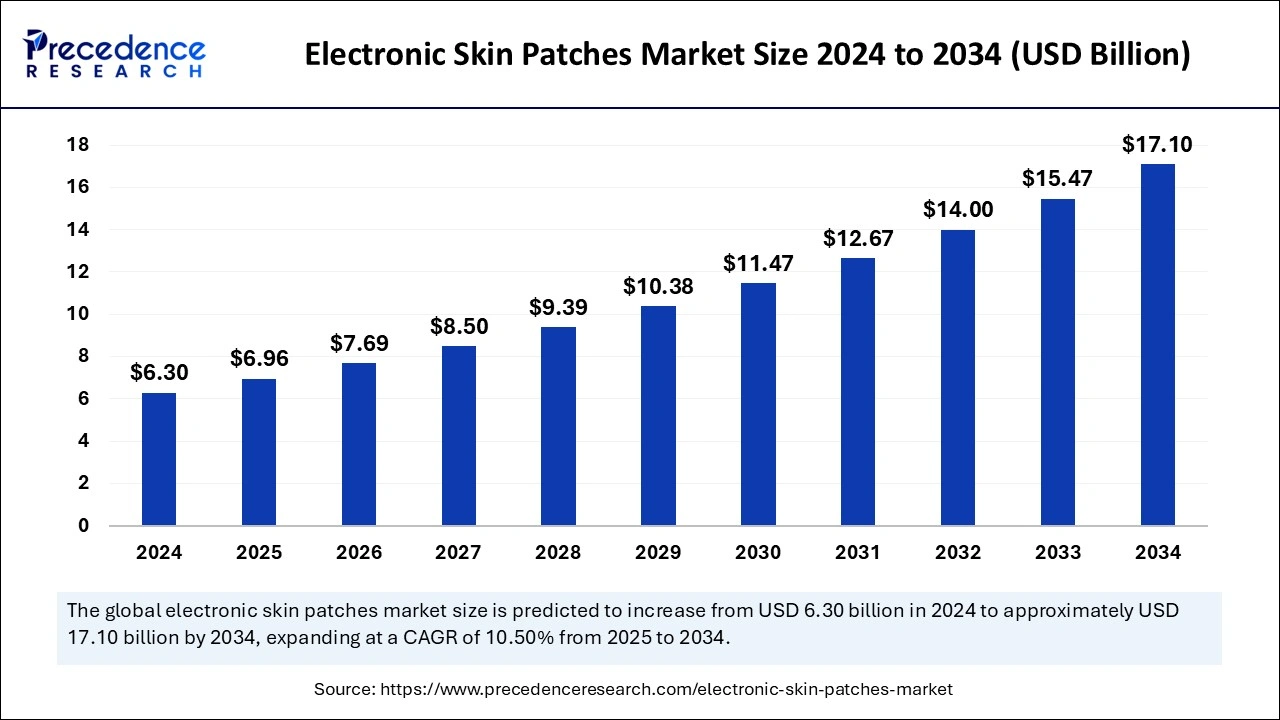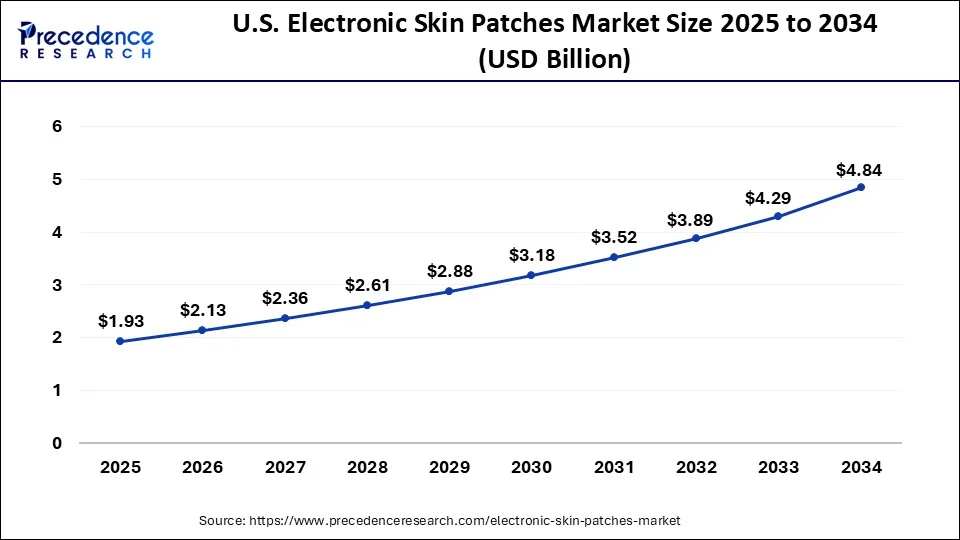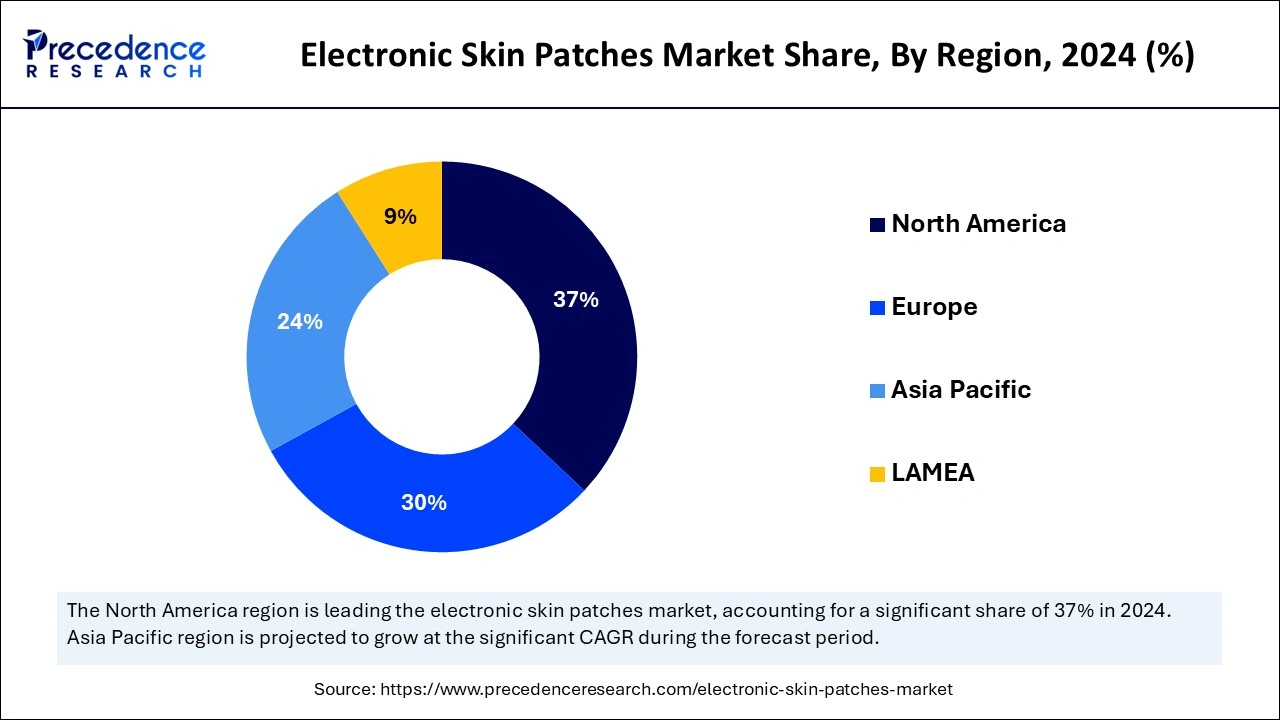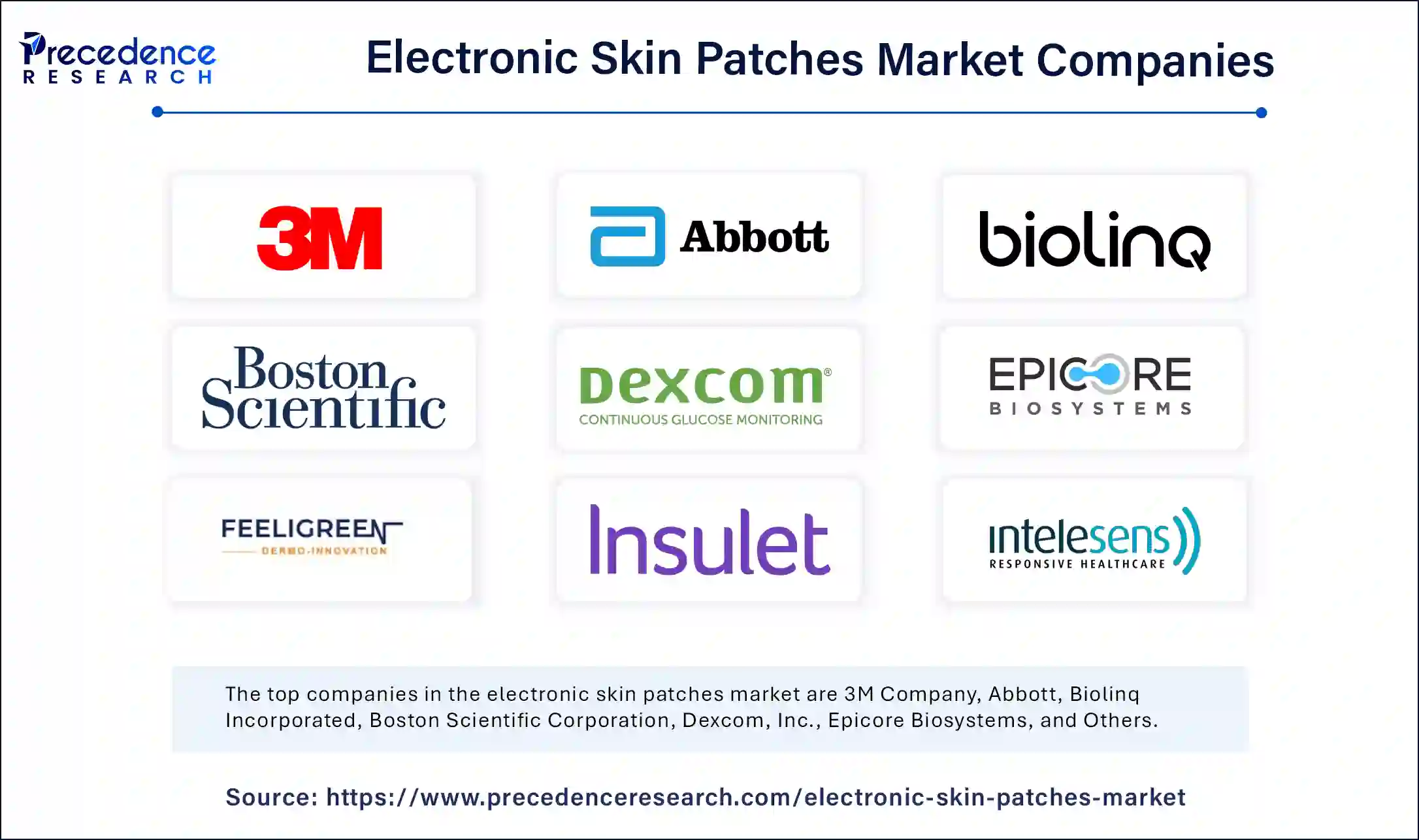List of Contents
What is the Electronic Skin Patches Market Size?
The global electronic skin patches market size is estimated at USD 6.96 billion in 2025 and is predicted to increase from USD 7.69 billion in 2026 to approximately USD 17.10 billion by 2034, expanding at a CAGR of 10.50% from 2025 to 2034. The rising demand for a non-invasive and comfortable approach to monitoring vital signs and other physiological parameters contributes to the growth of the electronic skin patch market.

Electronic Skin Patches Market Key Takeaways
- North America dominated the electronic skin patches market with the largest share of 37% in 2024.
- Asia Pacific is anticipated to show significant expansion over the forecast period.
- By type, the monitoring & diagnostics segment accounted for a considerable share of the electronic skin patches market in 2024
- By application, the diabetes management segment held a dominant presence in the market in 2024.
- By application, the cardiovascular monitor segment is expected to grow at the fastest rate during the forecast period.
- By patient, the adult patch segment accounted for a considerable share of the market in 2024.
- By material, the silicone segment dominated the market in 2024.
- By end-user, the hospital & clinics segment marked its dominance over the market in 2024.
Market Overview
Electronic skin patches are an advancement towards wearable technology in the medical device sector. The design of an electronic skin patch consists of a flexible product that is attached to an individual's skin with the help of a biocompatible adhesive. It comprises electronic components such as sensors, processors, and communication elements. It is commonly used to count steps, monitor cardiac rhythm and temperature, drugs and cosmetic delivery, smart wound care, and many more things similar to a smartwatch.
Electronic skin patches help in improving health and provide clinical outcomes. In contrast to traditional medical devices, these devices are compact, lightweight, more comfortable, and less intrusive for users. These patches have additional features for single-use, short-term, or extended use.
How is Artificial Intelligence (AI) Changing the Electronic Skin Patches Market?
The integration of artificial intelligence into electronic skin patches has transformed the medical device industry. AI holds the potential to optimize the device's material by bringing innovative discoveries and sensor designs to a new automated e-skin patch. Along with that, it helps analyze health data collected by electronic skin devices. It is expected to show promising outcomes with high-accuracy diagnosis in cardiac complications.
AI can rapidly detect even small and gradual cardiovascular changes. It also predicts mental health issues by offering real-time monitoring of stress hormones. Furthermore, in manipulating robotics and providing human aid, AI-powered electronic skin in a human-machine interface offers rapid analysis and interpretation of multimodal data. It captures complex hand movements and transmits physical information to the computer systems making commands.
Electronic Skin Patches Market Growth Factors
- Manufacturing partnership: This offers development advances through a multitude of capabilities. Collaboration of material expertise and manufacturers produce suitable test patches and tapes. Manufacturers benefit from design and engineering consultation in a smooth transition and product development.
- Sensor technology:It facilitates enhancing the effectiveness and functionality of the electronic skin patches by capturing and analyzing real-time data. This data-driven approach benefits healthcare professionals by helping them make thoughtful decisions, optimize treatment plans, and improve patient results.
- Health monitoring: Electronic skin patches are considered one of the smart medical devices used for physiological and chemical indicators of health. This device monitors and measures various parameters such as boy motions, body temperature, skin hydration, metabolic biomarkers, and brain and heart functionality through electrocardiogram and electroencephalogram.
- Drug and cosmetic delivery: Skin patches increase the efficiency of drugs and cosmetics in releasing them into the skin; they use a small amount of electric current to push the molecules inside the skin. Several patches are equipped with coin cell batteries to generate current, which are for disposable and single-use applications.
Market Key Trend
The electronic skin patches market is experiencing robust expansion, fueled by the convergence of wearable technology, health monitoring, and personalized medicine. A significant trend in this space is the rising demand for non-invasive, skin-adherent medical devices capable of continuously tracking physiological parameters like heart rate, glucose levels, hydration, and temperature. These ultra-thin, flexible patches provide real-time data, making them essential tools in chronic disease management, elderly care, and sports performance optimization. Furthermore, there is a growing push toward smart diagnostics and therapeutic patches integrated with microfluidic components and wireless connectivity. These innovations allow for not only passive monitoring but also active intervention, such as controlled drug delivery. The integration of biodegradable and skin-compatible materials is another emerging trend, aligning with sustainability goals and reducing the risk of irritation for long-term users.
Market Scope
| Report Coverage | Details |
| Market Size by 2034 | USD 17.10 Billion |
| Market Size in 2026 | USD 7.69 Billion |
| Market Size in 2025 | USD 6.96 Billion |
| Market Growth Rate from 2025 to 2034 | CAGR of 10.50% |
| Dominating Region | North America |
| Fastest Growing Region | Asia Pacific |
| Base Year | 2024 |
| Forecast Period | 2025 to 2034 |
| Segments Covered | Type, Application, Patient, Material, End-Use, and Regions. |
| Regions Covered | North America, Europe, Asia-Pacific, Latin America, and Middle East & Africa |
Market Dynamics
Drivers
A broad range of application
The electronic skin patch device is proven to be an excellent device for remote monitoring for both inpatient and outpatient due to its reliable and convenient properties. The attached skin patch helps in the management and monitoring of diabetes, cardiovascular disease, and many more. Other than healthcare monitoring, athletes use it while running marathons to measure the distance, pay close attention to heart rates, and analyze their performance. Electronic skin patches are also used in robotics to sense the touch and interact with environmental objects more delicately, prosthetics to provide sensory feedback to amputees, and even in consumer electronics for personalized health tracking.
Restraint
Slow growth in material development
Wearable technology is advancing in terms of features, but the material is still behind. Most wearable devices have a rigid and sometimes bulky design, and they cannot be worn directly attached to the body. This creates discomfort and may also provide inaccurate results, especially for heart patients; inaccurate heart rate measurements can give false indications, leading to overexertion and further health issues. In some cases, the material may not be compatible with the skin, which might cause irritation and other health complications. Human skin naturally produces oils and sweat, which hinders the adhesive's sticking properties. It is extremely crucial to test direct-to-skin adhesive, which includes acrylic, rubber-based, and silicone, before wearing the device.
Opportunity
Robotics and prosthetics
The electronic skin patches market is anticipated to expand more significantly towards robotics and prosthetics. Future trends and technologies will bring a revolutionary change in electronic skin technology, from self-healing to material advancement and sensing functions. Bluetooth-connected polymers are expected to be witnessed, and they will offer wireless monitoring of human vital signs, speech, and coughing rates. Electronic skin will evolve in the robotics field by enhancing interaction and communication between robots and humans by enabling robotics to feel temperature, pressure, textures, shape, and many more.
Segmental Insights
Type Insights
The monitoring & diagnostics segment accounted for a considerable share of the electronic skin patches market in 2024. The e-skin patches commonly used for medical monitoring and diagnosis which includes monitoring heart, diabetes management, fertility, sleep, brain activity, and pregnancy, contribute to the dominance of this segment. They are utilized for different purposes as required such as during sports activities and for control and surveillance of different medical conditions. The innovative fabricated technique used in skin patches provides simultaneous monitoring of various parts of the body parameters while providing temperature-moisture management.
The therapeutic Electronic skin patches segment is anticipated to grow with the highest CAGR during the studied years. The electronic skin patch device can deliver medications and nutrients into to body through minimal invasion. This aids in treating the disease and preventing illness and other medical complications.
Application Insights
The diabetes management segment held a dominant presence in the market in 2024. Diabetes management is achieved by an e-skin patch as it offers continuous glucose monitoring (CGM) and insulin patch pumps. The electronic skin patches sense the excess glucose in sweat and automatically administer drugs by heating up microneedles that penetrate the skin. The sensors are made from enzyme-based glucose which keeps an account of pH and temperature to improve the accuracy of glucose measurement from sweat.
The cardiovascular monitor segment is expected to grow at the fastest rate during the forecast period of 2025 to 2034 due to its thin, stretchable, and flexible property of patches which can be used to monitor cardiovascular health. These skin patches are worn on the skin for continuous monitoring of heart, blood pressure, and other essential vital signs.
- Two companies, STMicroelectronics and DuPont are combining their expertise to develop intelligent e-skin patches to self-sense cardiac events in patients. These devices understand electrical and mechanical heart activities.
Patient Insights
The adult patch segment accounted for a considerable share of the market in 2024. the dominance of this segment is credited to the more usability of electric skin patches among adults. Adults use skin patches for prevention, diagnosis, and treatment of illness and injuries, it is commonly used by sports athletes to monitor their performance. Adults use it to monitor glucose level, activating attached components including diabetes medicine dispense, drug and cosmetic delivery, and electrical stimulation devices.
Pediatric patch segment is anticipated to grow with the highest CAGR during the studied years. the electronic skin patches used for pediatrics allows for a proper diagnosis, treatment and management of health condition depending on the age of the particular child. This device helps in early detection of the presence of any critical conditions in childing which leads to timely treatment and enhanced quality of life.
- In December 2024, the Children's National Hospital and the U.S. Food and Drug Administration has collaborated to help advance pediatric health. The aim is to address long-standing challenges in testing medica devices for childing and perinatal care.
Material Insights
The silicone segment dominated the market in 2024. The electronic skin patches are commonly made from silicone-based material including silicon nanomembranes. Silicones offer unique properties such as flexibility, excellent conductivity, and the ability to be tailored into intricate circuits while maintaining their thin and conformable form. This mimics the characteristics of human skin, making it comfortable to wear.
The polymer segment is observed to be the fastest-growing in the market during the forecast period. recently scientists have proven that polymer electrodes for electric skin patch applications are ideal due to their improved electrical conductivity. Along with that, this is a cheaper and simpler alternative. Still, there are more enhancements needed when it comes to using polymer as a viable alternative. This material is non-toxic which significantly improves performance and has biocompatibility with human skin.
End-Use Insights
The hospital & clinics segment marked its dominance over the market in 2024. electronic skin patches have become an essential healthcare tool and is expected to expand more in the future. In hospitals and clinics, this is administrated by professionals for better, accurate diagnosis of disease, monitoring of the condition, intensive care, and continuous monitoring of vitals.
The specialty clinics segment is expected to grow at the fastest rate in the market during the forecast period of 2024 to 2034. The usage and performance is the same as it is done in hospitals and clinics. However, specialty clinics have the advantage of offering personalized treatment plans within specific specialties. Additionally, there is an increasing demand for focus and advanced medical care through specialized expertise.
Regional Insights
U.S. Electronic Skin Patches Market Size and Growth 2025 to 2034
The U.S. electronic skin patches market size is exhibited at USD 1.93 billion in 2025 and is projected to be worth around USD 4.84 billion by 2034, growing at a CAGR of 10.70% from 2025 to 2034.

Market Mastery: North America Takes the Helm in the Electronic Skin Patches Market
North America dominates the electronic skin patches market with the largest revenue share. The primary drivers of electronic skin patches in North America are healthcare spending and research and development into designing innovative products. The best medical device companies in America are Medtronic, Johnsons & Johnson's, Abbott, SIEMENS, and many more, bringing significant innovations that have changed the healthcare industry.
The National Health Expenditure Accountants (NHEA) from the Centers for Medicare & Medicaid Services (CMS) provide data on health spending in the United States. The spending includes the type of service, funding, sponsor, and inflation adjustment. In 2023, the United States spent over $4.9 trillion on health care, which is 7.5% more than in previous years. To date, the United States has spent more than 67.1 billion on medical devices.
A Skin-Deep Tech Frontier
North America continues to dominate the electronic skin patches market, largely due to its advanced healthcare infrastructure, supportive regulatory frameworks, and technological leadership. The United States plays a pivotal role, driven by extensive R&D investment, high adoption of wearable health technologies, and collaborations between medical institutions, tech companies, and government agencies. Government-backed initiatives such as remote patient monitoring reimbursements under Medicare and Medicaid, along with the FDA's fast-tracking of digital therapeutics, have encouraged both innovation and commercialization of electronic skin patch solutions. Canada also contributes meaningfully, thanks to its universal healthcare model and growing support for digital health startups. These governmental efforts have created a favorable environment for product testing, clinical trials, and mass deployment across hospitals, homes, and even military healthcare units.
U.S. Electronic Skin Patches Market Trends
In the U.S., the market is being propelled by rising demand for non‑invasive, continuous health monitoring, particularly in chronic disease management, enabling real-time tracking of vitals such as ECG, glucose, and hydration. The U.S. government is supporting the market through increased reimbursement for remote monitoring, a favorable regulatory environment, and dedicated research funding. Additionally, the FDA facilitates market growth by granting approvals and clearances for innovative electronic skin patch solutions, ensuring safety and encouraging adoption.

Asia Pacific on Rise: Electronic Skin Patches Market to Witness Unpredictable Growth
Asia Pacific is expected to grow at the fastest rate during the forecast period. The expansion of this region is credited to the increasing awareness of chronic disease, government investment in healthcare, and collaboration among industry leaders. Wearable health monitoring devices are greatly adopted in this region as they offer significant potential in the effective management of chronic disease.
Sensing the Future
Asia-Pacific is rapidly emerging as the fastest-growing region in the electronic skin patches market, driven by population density, increasing healthcare demands, rising chronic diseases, and greater digital awareness. Countries like China, India, Japan, and South Korea are at the forefront of this growth, investing in local manufacturing and digital health ecosystems. The rise of urbanization and smartphone penetration has created a fertile ground for mobile health integration, where patients can monitor their vitals via patches connected to health apps.
Top leaders of continuous glucose monitors (CGMs) are Dexcom, Medtronic, Abbott, Senseonics, and Ascensia in Asia Pacific, which helps in diabetes management by providing real-time glucose reading, which results in precise insulin dosage and improved glycemic control. The Chinese government has increased its investment in healthcare infrastructure by 5.9% of GDP by 2030, according to the Health Research Policy and Systems.
India Electronic Skin Patches Market Trends
In October 2025, India's Ministry of Electronics and Information Technology approved seven projects under the Electronics Component Manufacturing Scheme (ECMS), totaling private investments of ₹5,532 crore, including five in Tamil Nadu and one each in Andhra Pradesh and Madhya Pradesh. Major factors such as increased research funding, support for the MedTech sector, telemedicine initiatives, and novel technological innovations are driving market growth. These efforts are also enhancing domestic manufacturing capabilities and expanding access to advanced wearable healthcare solutions across India.
How is the Opportunistic Rise of Europe in the Electronic Skin Patches Market?
Europe is witnessing a rapid rise in the electronic skin patches market, driven by growing demand for digital health solutions and wearable monitoring devices. National healthcare programs and EU regulatory bodies strongly support the adoption of digital health technologies, facilitating integration into clinical practice. Additionally, EU funding initiatives, such as Horizon Europe, provide significant support for research and innovation in healthcare and flexible electronics, further accelerating market growth.
France Electronic Skin Patches Market Trends
In France, the market is being driven by a strong push toward preventive healthcare, particularly in managing chronic diseases among its aging population. In September 2025, the French National Authority for Health introduced evaluation principles for digital medical devices, establishing standard reimbursement through the national list of medical telemonitoring activities. This framework also provides reimbursement for telemonitoring and therapeutic digital medical devices, supporting broader adoption of electronic skin patches and other digital health technologies.
What Potentiates the Growth of the Latin American Electronic Skin Patches Market?
The Latin American market is being driven by the growing adoption of remote health monitoring, the rising incidence of chronic diseases, and strategic collaborations across the healthcare sector. Favorable government policies, supportive regulatory frameworks, and potential reimbursement for digital health technologies further enhance the market's growth prospects in the region. Brazil leads the market, driven by strong policy support from Brazil's public health system (SUS) and a stable regulatory framework for telemedicine, backed by data protection laws, which enhances the adoption of these wearable devices. The Brazilian government also invests in acquiring various medical equipment for primary healthcare, including advanced monitoring devices.
What Opportunities Exist in the Middle East & Africa?
The Middle East & Africa (MEA) offers immense opportunities in the electronic skin patches market, fueled by advancements in AI-driven analytics, flexible electronics, and biosensor technology. The rising adoption of wearable medical devices, along with private-sector innovation and investment, is further expanding market opportunities across the region.
Saudi Arabia is a major contributor to the market. In Saudi Arabia, the electronic skin patch market is being driven by Vision 2030�led digital health investments, including telemedicine expansion and AI‑powered remote patient monitoring. At the same time, clear regulatory guidance from the Saudi Food & Drug Authority for digital health products and a growing prevalence of chronic diseases like diabetes and cardiovascular conditions are pushing greater adoption of wearable patches in both clinical and home‑care settings.
Electronic Skin Patches Market Companies

- 3M Company
- Abbott
- Biolinq Incorporated
- Boston Scientific Corporation
- Dexcom, Inc.
- Epicore Biosystems
- Feeligreen
- GENTAG, Inc.
- Insulet Corporation
- Intelesens Ltd.
- Koninklijike Philips N.V.
- Linxens Healthcare
- Medtronic, Inc.
- Resonetics
- VitalConnect
Transforming Lives Through Education: Success Stories of Universities
- Standford University researchers developed an artificial e-skin that is soft and stretchable. It is integrated with new electronics which sense pressure, strain, and temperature. These impulses are sent to the brain, which enables amputees to control prosthetic limbs with sensory feedback.
- University of Tokyo researchers developed an ultra-flexible, ultrathin protective layer by creating an air-stable, organic light-emitting diode (OLED) display. This technology allows the creation of electronic skin displays of blood oxygen, heart rate sensors for athletes, and many more applications.
- The University of Colorado Boulder developed a self-healing, recyclable electronic skin that can sense temperature, touch, airflow, and humidity, which can be used for interactive devices and environmental sensing.
- Graz University of Technology has developed a hybrid smart skin material that senses temperature, pressure, and moisture. It can be used as next-generation artificial skin.
Recent Updates on Electronic Skin Patches
Advancements in wearable skin patches revolutionize healthcare
- On 15 March 2025, Electronic skin patch advancements are revolutionizing patient monitoring and care. Real-time data collection increased comfort, and more precise health insights are now provided by these patches with numerous applications in wound care, chronic disease management, and rehabilitation. The market for electronic skin patches has grown significantly in tandem with the growing demand for non-invasive continuous monitoring devices.
New applications and product innovations promise brighter prospects
- By May 2025, New advancements in smart materials and flexible electronics are opening the door for the next generation of skin patches. Among the noteworthy innovations are patches for glucose monitoring, medication delivery, and even pain-relieving electrotherapy. These developments are anticipated to propel the market for electronic skin patches forward, providing a wider range of healthcare solutions, as evidenced by an increasing number of clinical trials and product approvals.
Recent Developments
- In January 2025, Phantom Neuro introduced a muscle implant enabling amputees to control prosthetic limbs with their thoughts. This groundbreaking technology allows users to move prosthetics without the need for invasive brain surgery, marking a significant advancement in neuroproteins. By integrating seamlessly with electronic skin patches, the implant enhances the functionality of wearable devices, offering improved mobility and quality of life for amputees. This innovation underscores the potential of combining neural interfaces with wearable technology to create more intuitive prosthetic solutions.
- In March 2025, Epicore Biosystems launched a next-generation sweat-sensing patch for hydration monitoring. The new patch offers real-time analysis of sweat composition, enabling users to monitor hydration levels and electrolyte balance during physical activities. Designed for athletes and individuals in demanding environments, the device provides actionable insights to prevent dehydration and optimize performance. Its integration with mobile applications allows for personalized hydration strategies based on individual sweat profiles.
- In November 2024, Henkel and Linxens collaborated to integrate advanced technologies for medical wearables based on printed electronics and demonstrated electronic skin patches. Companies have incorporated a self-regulating heating element into medical wearable devices, which significantly enhances the comfort of patients' wear.
- In October 2024, Researchers from the University of Chicago designed a skin patch that uses imperceptible electric current to control microbes and stop bacterial infection without using any drugs. This is known as the Bioelectronic Localized Antimicrobial Stimulation Therapy (BLAST) patch. The aim of this device is to target specific skin bacteria that cause infection risks.
Segments Covered in the Report
By Type
- Iontophoretic Patches
- Monitoring & Diagnostic Patches
- Therapeutic Electronic Skin Patches
- Others
By Application
- General Patient Monitoring
- Diabetes Management
- Cardiovascular Monitoring
- Wound Care
- Others
By Patient
- Adult Patch
- Pediatric Patch
By Material
- Polymer Patch
- Silicone Patch
By End-Use
- Hospitals & Clinics
- Specialty Clinics
- Ambulatory Care
- Other
By Region
- North America
- Europe
- Asia Pacific
- Latin America
- Middle East and Africa
For inquiries regarding discounts, bulk purchases, or customization requests, please contact us at sales@precedenceresearch.com
Frequently Asked Questions
Ask For Sample
No cookie-cutter, only authentic analysis – take the 1st step to become a Precedence Research client



